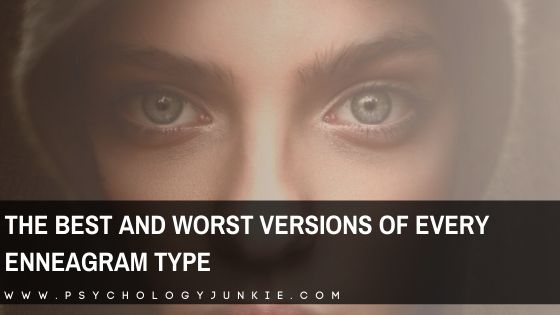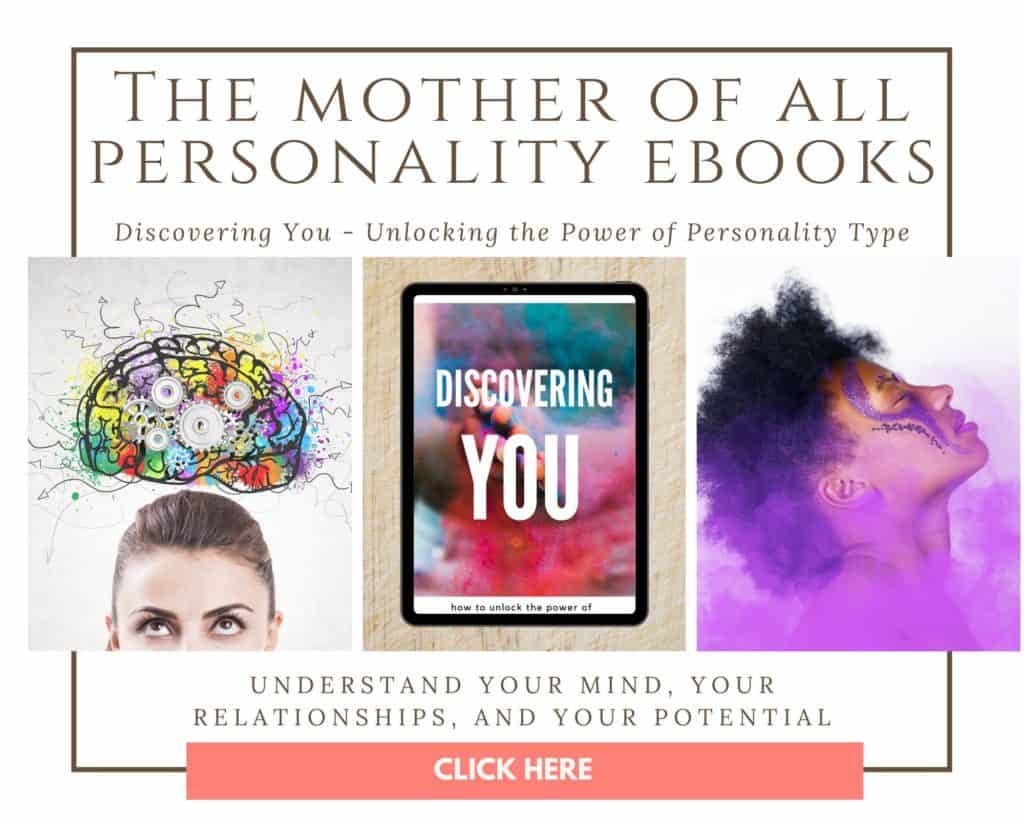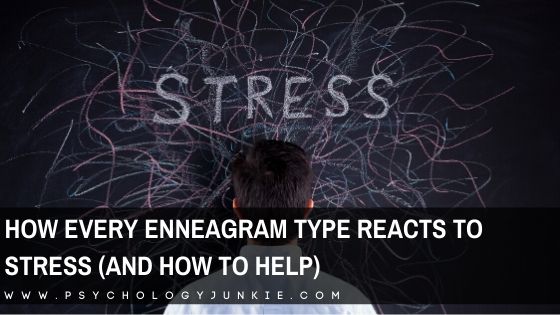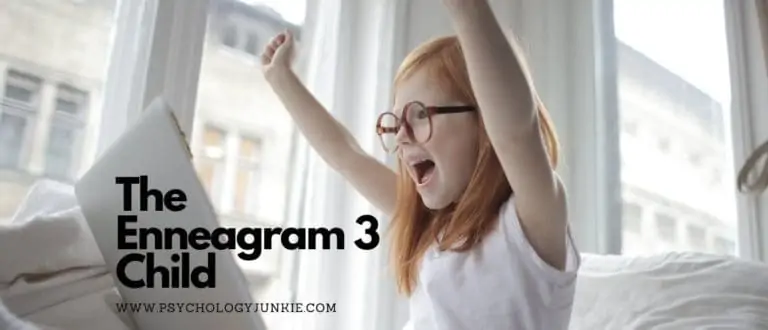The Best and Worst Versions of Every Enneagram Type
In the enneagram system of typology, each of us has different levels of health. An unhealthy Six, for example, is typically suspicious, paranoid, and riddled with unreasonable anxieties. A healthy six is courageous, comforting, and healthily skeptical.
What are the best and worst versions of your enneatype? Let’s take a look!

Not sure what your enneagram type is? Take our new personality questionnaire here!
Enneagram Ones at Their Best:
Healthy Ones have a sense of integrity that drives them in all of their endeavors. However, they aren’t slaves to perfection. They realize that flawlessness is impossible in themselves and others, and so they let go of the feeling that they have to be their own harshest critics. It’s paramount for the healthy One to live in accordance with their conscience and to do what they feel is right. But they also know how to relax and enjoy the simpler pleasures of life instead of working themselves to a point of exhaustion. They have a generous, uplifting countenance and are realistic about the state of the world and their expectations of themselves and others. Rather than reacting to life’s problems and the failures of others with harsh criticism or emotion, they are accepting when needed and calmly try to understand the perspective of the person involved. Ones believe it is essential for them to do what is best for the greater good, so they are very capable of selflessness, kindness, and nobility.
Enneagram Ones at Their Worst:
At their worst, Ones are self-righteous, cruel, and hypocritical. They act out repressed desires that they condemn in others but justify in themselves. They are plagued by worry that their ideals are wrong, but the possibility of being wrong is too much for their fragile egos to handle. Showing mercy or sympathy is beyond them because they are so overwhelmed by a sense of righteous anger and retribution that they won’t allow any empathy or forgiveness. When they take out their judgmental actions and beliefs on others, they see it as a righteous act and refuse to personalize or take responsibility for what they are doing. They are belittling, critical, and obsessive.
Find out more about enneatype One.
Enneagram Twos at Their Best:
Healthy Twos are the picture of selflessness and generosity. Empathic and kind-hearted, they genuinely care for people without worrying about what they will get in return. Not only do they nurture and care for others, they nurture and care for themselves. In fact, the more they nurture themselves, the more they are able to nurture others effectively. Knowing this, they balance their deep generosity and empathy with clarity into their own feelings, motives, and needs. At this level, Twos are non-judgmental, authentic, and profoundly altruistic. They are supremely interested in making the world a better place for others without a care for recognition. They’re the kinds of people who will give gifts anonymously because the joy for them is in helping the other person, not being praised for the giving.
Enneagram Twos at Their Worst:
At their worst, Twos are manipulative, self-interested, and needy. They must see themselves as good, so they rationalize the way they manipulate people, often seeing themselves as victims who deserve whatever positive feelings they get out of the manipulation. Guilt becomes a weapon that they know how to wield with precision.
“They undermine others while presenting themselves as “helpers” who can heal the pain they have subtly caused. They prick at tender spots with one hand while soothing the hurt with the other; they put people down and then bolster their self-confidence with left-handed compliments”
– Don Richard Riso, Personality Types – Using the Enneagram for Self-Discovery
An insidious form of co-dependency becomes the problem of the unhealthy Two. They need to be needed, and they will manipulate and disable others in order to feel needed. They will help just enough to make the other person feel grateful, then they will remind that person of how lost they would be without their help. They never let people forget their problems, bringing up past offenses as a way to guilt others into feeling indebted to them. They may even use sickness or dishonesty to play the victim in order to get pity. If they can’t get love, pity is usually the next best thing they can attain.
Find out more about enneatype Two.
Enneagram Threes at Their Best:
Healthy Threes are highly goal-oriented and driven. However, rather than being compelled by recognition and reward, they desire to live a life that aligns with their deeply-felt values. Authentic and modest, they look their weaknesses square in the face and know how to make fun of themselves, because they don’t have any false ideals about who they are. They also know their strengths and will maximize those to the best of their ability. Their practicality and compassion make them skilled mentors for those who are struggling to find their path in life. Often, the three will find a way to motivate people towards a higher purpose and calling. Threes at their best want to make the world a better place for others, and will give charitably to help people who are less fortunate. At this level, they see themselves as intrinsically linked to the rest of the human race. They realize that every action has a consequence in the world around them, so they prioritize making responsible actions for the people they influence. If they are wealthy, they consider it their highest calling to help those less fortunate. It’s important for them to use any of their gifts to proactively improve the human experience.
Enneagram Threes at Their Worst:
At their worst, Threes are addicted to feelings of admiration and success and will do nearly anything to get it. This leads them to making up grand stories about themselves and then having to be more deceitful to make those stories seem plausible. They live with a nagging fear that their dishonesty and emptiness will be exposed and that they will lose all the relationships that matter to them. This leads them to never really being authentic with anyone, and short-term relationships are all that they can procure. Making an impression is vital to them, even if it might cause others harm. They show off an image of cool-headed success, but will have no issue playing friends off of each other or sabotaging relationships in order to maintain their image. Anything from plagiarizing, lying, or taking credit for other’s achievements is fair game to them. They have no loyalty to any particular cause or belief system – they will change their ties depending on what will help them to come out on top. At this level, Threes see value in people only insomuch as those people make them feel. People are tools to be used rather than individuals to be respected.
Find out more about enneatype Three.
Enneagram Fours at Their Best:
Creative and empathic, healthy Fours have a profound awareness of their unconscious selves. They are driven by their inspiration, bringing meaningful pieces of art or writing into the world in a way that transforms people’s lives. They discover their identity through their creativity, drawing sources of inspiration from outside and inside themselves. Their intuition about themselves and others is often staggering. They seem to know the emotional wavelengths all around them and can easily put themselves in other people’s shoes. They use their deep, empathic nature to connect with others and see what they have in common. Their creativity is often novel and transformative – something that has truly never seen before. But they don’t force themselves to create – they simply follow their intuition and inspiration as it strikes. At this level, Fours have transcended their ego and are especially life-enhancing. They help people to understand themselves and the human experience in powerful ways.
Enneagram Fours at Their Worst:
At their unhealthiest level, Fours are filled with self-hatred and self-pity. They are often self-destructive, turning to drugs, alcohol, or suicide attempts as a way to cope with their increasing feelings of shame. The rest of the world seems like a constant reminder to them of how much they have failed. Happy songs mock them, couples in happy relationship feel taunting to them, and they tend to misinterpret everything as a personal attack or a sign of their failure in life. Because this is so exhausting for them, they feel like giving up on life and withdraw from everything outside themselves. They become convinced that they are outcasts or martyrs, and that nobody could possibly understand their pain and suffering. It’s normal for them to feel shocked in counseling sessions that other people might have suffered as much as they have. At this level, they envy the same people they criticize. The “normal” people who they imagine have it so easy without even trying. Inwardly, they hope that someone will come and rescue them from their misery – but it feels impossible because they struggle to make an appearance in the real world.
Find out more about enneatype Fours.
Enneagram Fives at Their Best:
At their best, Fives discover profound realities that change the shape of the world. Progressive and open-minded, they have remarkable foresight into what is likely to happen in the future. They see the big picture and can often anticipate events and conclusions far earlier than other types can. Originality seeps into everything they do – but it’s not stemming from a desire to be unique as much as their ability to naturally see connections that others do not. Whether they are artists or scientists, their creations and discoveries seem profoundly new. Instead of using their mind to defend themselves against reality, Fives at this level embrace reality in and accept that they don’t know everything. Intellectual pioneers, they revolutionize the way the world works and make innovative breakthroughs that are staggering to many. Yet even with all their mental prowess, they still have a humble compassion for the people they meet and are happy to help others with their insights.
Enneagram Fives at Their Worst:
At their worst, Fives seclude themselves from the world and reality and are antagonists to those who try to connect with them. Everything feels threatening to them, but especially their own self-doubt. They feel incapable of handling life, but fight against this by debunking other people’s ideas and isolating themselves. Overwhelmed by dark fantasies, they take on a nihilistic, eccentric outlook on life. Sometimes this becomes so extreme that they develop schizoid tendencies. At their worst, they take joy in debunking other people’s beliefs and happy experiences. They see others as living in a “fool’s paradise” and feel nothing but revulsion at human nature. They burn bridges, turn their back on friends and family, and identify with the emptiness inside themselves. Sleep is nearly impossible because their minds are so full of horrors and destructive fantasies. The aggression, exhaustion, and frustration they feel is completely overwhelming, but they feel no way to act on their aggressions. They have become too out of touch with reality, too disconnected from their bodies. It’s difficult for them to shower, eat properly, or do anything to care for themselves. They may rebelliously try out drugs or alcohol as a way of coping. Their phobias and terrors are so debilitating that they lose touch with any sense of reality.
Find out more about enneatype Fives.
Enneagram Sixes at Their Best
At their best, Sixes are deeply loyal, courageous, and supportive. They are usually effective leaders, knowing innately how to put people at ease and make them feel supported and secure. Because they know what it’s like to grapple with anxiety, they have a comforting, reassuring presence when others are anxious. Hard-working and self-reliant, Sixes at this level don’t feel like they need to find direction from outside sources all the time. They trust themselves, and have a clarity of mind that gives them confidence in their decisions. Valiant defenders of the downtrodden, they have no problem standing up to injustice or championing people they feel are being persecuted or marginalized. They are intuitive about risks, and know how to create effective contingency plans and circumvent obstacles.
Enneagram Sixes at Their Worst:
At their worst, Sixes become self-defeating, masochistic, and terrified of everyone and everything – including themselves. They are so overcome by their fears that they can’t concentrate on their work or responsibilities, so their tasks are done poorly and with many errors. At earlier levels of disintegration, Sixes complain and ramble about all their problems and fears, hoping that someone will rescue them or commiserate with them. At their unhealthiest level, they refrain from doing so because of their intense fears of abandonment. They’ve learned at this point that people tire of complaining and conspiracy theories and they desperately don’t want to be rejected. They feel furious at themselves and at the people they feel have betrayed them and abandoned them. Many times, Sixes who have reached this level of disintegration had abusive childhoods. They want an authority figure to reassure them, but the kinder the authority figure is, the more that figure terrifies them because their kindness is unfamiliar. Because of this, they may seek out abusive authority figures because at least they know what that abusive relationship is like. They may punish themselves or degrade themselves, turning their aggression and fury against themselves. They feel like if they hurt themselves nobody else will. Their masochistic behavior is, in part, a cry for help. They want someone to see them in their suffering, punish them, and then love them. They carry around their fears and anxieties like heavy chains that keep them from being active and engaged in life.
Find out more about enneatype Sixes.
Enneagram Sevens at Their Best:
At their best, Sevens are filled with a profound joy of life and its inherent value. They live moment to moment with a gratefulness and openness to life and all its experiences. Rather than consuming more or being materialistic, they find immense gratitude for everything that they have. They are constantly surprised by life and each beautiful detail it involves – the sparkle of dew on the grass, the laugh of a child, or the sound of a breeze dancing through the leaves. Their joy is infectious and many are drawn to them for their vitality and exuberance. In their minds, life is a holy treasure and the world is something to be experienced, treasured, and revered. They have respect for nature and will do what they can to help the world in tangible ways. At this level, Sevens are mentally quick and have an unquenchable curiosity to learn new things. They learn quickly and are highly resourceful – making the most of any situation they find themselves in. Because of their joy, intelligence, and resourcefulness, they are surprisingly resilient and can rebound from any setback with grace.
Enneagram Sevens at Their Worst:
Impulsive and frenetic, Sevens at their worst look for pleasure and distraction everywhere. They hate to be still because it might cause them to face their own anxieties and grief. Instead, they chase after pleasure – finding it in excessive sex, drugs, alcohol, or materialism. Typically poor at handling money, they rack up debt in their efforts to find possessions or experiences that will keep them busy. When they don’t get what they want, they have “tantrums” and become aggressive, lashing out at the people around them. At this level, Sevens can act like bullies, pressuring others to join them in their self-destructive activities. They might make fun of people who won’t try a risky drug with them or reject people who aren’t willing to take risks with them. Unfortunately, their risky activities don’t even give them pleasure most of the time. They are exhausted, often struggling to sleep at night because they don’t want to face their own thoughts or anxieties. They tend to appear like spoiled children, impulsively saying whatever they think of and over-reacting to anything that upsets them. They are typically seen as obnoxious and childish, with no ability to inhibit their impulses.
Find out more about enneatype Sevens.
Enneagram Eights at Their Best:
At their best, Eights are gentle, faithful, and courageous. Heroic in nature, they have no qualms putting themselves in danger if it means protecting those they see as vulnerable or persecuted. That said, they don’t do so impulsively. They are very thoughtful and equipped with enormous resourcefulness – seeing opportunities where others fail to look. Big-hearted and compassionate, the healthy Eight generously helps others and is filled with both physical and moral courage. People flock to them for courage, guidance, and a sense of safety. Yet rather than being prideful and authoritative about this, they are benevolent and modest. They are anxious to solve people’s problems, provide practical resources, and stand up for the greater good. Their inner strength and bravery makes them a source of strength for many.
Enneagram Eights at Their Worst:
At their worst, Eights are ruthless, violent, and power-hungry. Often damaged by a violent or abusive childhood, Eights at this level are determined that no one will ever hurt them or get close to them again. They see acts of empathy or friendship as weakness, and can’t tolerate softness in anyone – especially themselves. Brutal and easily-angered, they have a might-makes-right philosophy on life that defies any moral code. In order to avoid guilt for their many wrongdoings, they commit more and more grievous acts, so as to weaken their conscience. They are often oppressive, dishonest, and retaliatory. They see weakness in any form as abhorrent and will go out of their way to demean those they see as frail or cowardly. All these violent, intimidating acts are coping mechanisms they’ve developed so that they don’t have to face the feeling of vulnerability, pain, and helplessness they faced as children.
Find out more about enneatype Eights.
Enneagram Nines at Their Best:
Deeply caring and peaceful, the healthy Nine feels at one with themselves and the world around them. In fact, they enjoy getting in touch with nature, animals, and music as a way to feel connected to something larger than themselves. Gentle and unassuming, these types have a great depth of caring for people and enjoy helping others – even their enemies. In fact, you could say the Biblical guidance of “Love your enemies. Do good to those who hate you” is more easily applied to a Nine. Rarely flustered, Nines have self-respect, dignity, and a sense of wonder that never seems to go away. While other types outgrow their childish wonder, Nines have an innocence and enchantment with the world that draws others in. This calm sense of contemplation can make them deeply spiritual or whimsical – often both. Their stable, comforting presence makes them a source of strength and solace for many. However, it’s important to note that they don’t give themselves wholly to self-sacrifice. They know what they want, think, and feel, and are capable of standing up for themselves and giving voice to their innermost thoughts. They are aware of their true worth, and this gives them a sense of dignity and confidence. Their indomitable spirit is admired by types – especially those who feel flustered and anxious throughout much of their lives.
Enneagram Nines at Their Worst:
At their worst, Nines are so distanced from themselves and their own feelings that they are unable to accomplish much of anything. They refuse to face the problems that surround them, instead choosing to live in denial and distraction. They may have make-believe scenarios or proverbs that they revert to when something is required of them or a conflict arises. More than anything, they don’t want to be affected by anything – themselves, others, or the world around them. They are inwardly furious at anyone for trying to get them to do anything, but they refuse to voice this anger. Rather they use passive-aggression to cope. They may agree to do something, then ignore it completely. They may give family members the silent treatment or tune out of the problems and struggles of their children. When they are called out on these behaviors, they act mystified and confused. They don’t understand how they could have caused a problem since they have been so conflict-avoidant. It surprises them how much they’ve cost their loved ones. The guilt could be overwhelming, but so as to avoid the guilt they repress their feelings. At this level, depersonalization is very common. In order to cope with their struggles and traumas, they will not accept reality and become vacant and removed.
Find out more about enneatype Nines.
What Are Your Thoughts?
Did you enjoy this article? Do you have any insights or thoughts to share? Let us know in the comments!
Find out more about your personality type in our eBooks, Discovering You: Unlocking the Power of Personality Type, The INFJ – Understanding the Mystic, and The INFP – Understanding the Dreamer. You can also connect with me via Facebook, Instagram, or Twitter!










Hey Susan, check out this website https://www.typologycentral.com/wiki/index.php/Enneagram_and_MBTI_Correlation You could use this to prioritize which Myers Briggs types are the most common Enneagram types, that way you wouldn’t have to do all 9 Enneatypes for each Myers Briggs types. Just a helpful hint! Thank you for this blog!
Because others are less common, they don’t deserve an article? ^^’
I could argue the opposite, if they’re common associations then there isn’t much more to say about them, while associations less unusual tend to seem more contradictory so they’re more interesting.